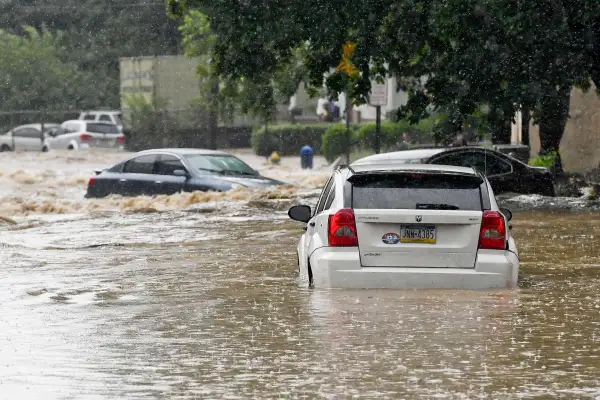Hurricanes and Insurance: All Water Damage Isn't the Same When It Comes to Coverage

Set to hit the Gulf Coast today and tomorrow, Hurricane Sally is forecast to bring rain that's especially heavy to areas that are unusually far inland, along with storm surges and a risk of tornadoes. Some of these perils are routinely covered by regular home insurance, while others aren't.
The National Hurricane Center advisory on Sally warns of winds high enough — at a sustained 85 mph — to qualify as hurricane strength, though those speeds are comparatively tame compared with the sustained 150 mph winds of Hurricane Laura last month. Yet Sally is also expected to move far inland, creating the conditions that the National Oceanic and Atmospheric Administration (NOAA) identifies as conducive to creating tornadoes.
But, as with Hurricane Isaias, water may be the most damaging element of Sally — and not from only the expected storm surge of between one and nine inched along coastal areas. The slow inland movement of Sally is also expected to create an unusual amount of rain. Where the typical hurricane brings six to 12 inches of rain, the NHC predicts "10 to 20 inches of rainfall with isolated amounts of 30 inches along and just inland of the central Gulf Coast from the western Florida Panhandle to far southeastern Mississippi. Historic flooding is possible."
Here’s a quick overview of how the predicted damage from Sally may or may not be covered by the typical insurance policies on homes and other possessions.
Homeowners policies don't cover damage from floods and storm surges
The rule of thumb with homeowners insurance is that if water touches the ground before entering your home, the incursion is technically considered to be a flood. And covering your home for flooding requires a separate insurance policy.
A storm surge isn't a flood technically speaking, but its consequences still aren't covered. According to the International Risk Management Institute, court cases have deemed a storm surge to be “little more than a synonym for a ‘tidal wave’ or ‘wind-driven flood,’ both of which are excluded under most property [insurance].”
Rain and tornado damage can usually be claimed
Your homeowners insurance will, however, protect you against damage from the rain and wind of a hurricane. Be aware, though, that a different (and higher) hurricane deductible will apply in a number of states, especially when it comes to wind effects. That list includes Alabama, Louisiana, and Mississippi, the states where Sally is expected to wreak the most damage. Residents should contact their insurance company to confirm coverage, including when those higher deductibles are triggered.
With sustained heavy rain expected from Sally, a good deal of damage could result from precipitation entering home directly. Examples include water damage to the interior from a leaking roof or through windows blown out by winds. However, the Insurance Information Institute warns that if poor maintenance contributed to causing the damage, or was found to make it worse, you might not be covered, at least not fully. So your claim might be denied or reduced if, as examples, your roof had been leaking for years and you failed to remedy the problem or if you left windows open during the storm to allow the rain in.
Unlike floods or earthquakes, tornadoes usually don’t require special coverage. That’s because, as American Family Insurance puts it, the insurance industry classifies tornadoes as windstorms, and windstorms are covered by most insurance policies. But the same caveat about negligence applies. Allstate warns, for example, that "your homeowners insurance policy likely won't pay for repairs if you neglected a rotted tree, which then fell onto your home during a tornado and caused damage.
Comprehensive coverage protects your cars
If your vehicles are damaged by a hurricane, including from flooding or a storm surges, you’re covered if you have what’s known as comprehensive coverage within your auto insurance policy. It’s the optional add-on that covers your car against such threats as theft, falling tree branches, and floods.
Fortunately, about 80% of car owners carry “comprehensive,” according to Mark Friedlander, Director of Corporate Communications with the Insurance Information Institute. But if you happen to have dropped the coverage for cost reasons, consider adding it back. You may even be able to do so in time to be covered should Sally strike your community tomorrow or later in the week.
Flood insurance takes time to get
Covering your property against flooding, whether from a hurricane or other weather, requires a separate policy. And those cannot be bought if a hurricane is only days or even weeks away from striking your area.
The main source of coverage, the federal National Flood Insurance Program, requires that you apply at least 30 days in advance of the date of coverage. Private insurers who offer flood insurance might write new policies more rapidly, says Insurance Information Institute spokesman Friedlander. But you shouldn’t expect to get a private flood policy in less than about five days, he adds.
More from Money
5 Ways to Lower What You Pay for Car Insurance During Coronavirus
Best Homeowners Insurance Companies of 2020
It's Hurricane Season: 5 Ways To Disaster-Proof Your Finances
